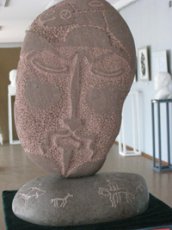|
 The genes of Alan-Goa, the mythological great-grandmother pf Genghis Khan and his son Jochi, were discovered by Kazakh geneticists in contemporary Todzhans - descendants of "Royal" Scythians. The genes of Alan-Goa, the mythological great-grandmother pf Genghis Khan and his son Jochi, were discovered by Kazakh geneticists in contemporary Todzhans - descendants of "Royal" Scythians.
When I found out that my genetic tree, which was kindly worked up for me by the molecular genetics laboratory in Alma-Ata, contains the genetic group "Rib", which is typical for representatives of descendants of the Celts (Irish, Scottish, and other Western Europeans) as well as Basques and Bashkirs, I was very surprised at first, because there were no migrants from Western Europe among my ancestors. But Siberian Scythians, Uighurs, Uriangkhai, Eastern Khakassians and Genghis Khan's "Mountain Mongols" were completely plausible.
However, as I analysed the probable genetic ties of my ancestors, especially their descent from their common great-great-grandmother Alan-Goa ("Mother-Deer"), whose name itself points to ethno-genetic ties to the "Royal" Scythians,, whose first legendary King-Sun was Koloksai, who is the legendary ancestor of Kol and Kular lineages, I came to the conclusion that the presence of Celtic genes in my own generic make-up is completely justifiable. Just like the presence of "signs" of "Arian" genes in Genghis Khan himself, which also appears to be a sufficiently well known historical fact (light hair, white skin, green eyes, etc.).
An interesting point is also the fact that the density of spread of this genetic marker approximately overlaps the areas of megalith builders in Western Europe. This suggests a suspicious connection between the increased frequency of freckling in Khakassians and their ancient megaliths, with especially prominent freckling in descendants of the Celts, as well as the Finno-Ugrian populations along the Volga, around the Ural mountains, and in Western Siberia.
Genghis Khan's probable genotype is believed to be Group "C", subgroup "C3", but it is of a very hypothetical character and its presence in contemporary "descendants" of Genghis kan (also probable, because the crushing majority of his real biological descendants was exterminated during the process of internecine warfare), does not rule out the possibility of a somewhat different genetic complex in other, that is, not Central-Mongol and Chinese, also hypothetical, branches of virtual "descendants", on the basis of whose genetic make-up was the illustrious "Genghis Khan's gene C3" calculated.
At the same time it is necessary to pay special attention to genetic research on descendants of Genghis Khan's oldest son Jochi and the Hazara, who very often exhibit our "Celtic" genetic group (i.e. Sayan -Altai and Bashkir).
The Hazara, as an ethnic group, originated form elite Mongol troops who remained in Afghanistan after the campaigns to the West.
They refer to themselves as "Hazara", which is derived from Persian "thousand". The Hazara are Shiites of Mongolian stock, and speak a language that belongs to the Iranian group. They inhabit central Afghanistan (according to various sources, they comprise about 8-10% of the total population of the country, which means approximately 2.8 to 3.8 million). About 32% of Hazara research subjects have the same genetic make-up as we do, on the other hand, there is a high percentage of congruence with genes of Genghis Khan's descendants.
We have weighty reasons to doubt the 100% correctness of the determination of "Genghis Khan's gene" as "C3", and all the reasons to believe that our genetic group is just as suitable for determining the genome of Genghis Khan's real descendants (or, more accurately, his older relatives), in fact, his eldest son Jochi and Aryan great-great-grandmother Alan-Goa. So much more because according to traditional Mongolian genealogy the family tree of Genghis Khan's "Golden family", to the time of his grandfather Kabul-Khan, was enumerated directly from Alan-Goa, i.e. the female line of the family.
However, the male line of the family appears to be generally mythical, or, more exactly, fictitious, because the male ancestors of Genghis Khan were born from the "pure womb" of Alan-Goa after the death of her lawful husband Dobu-Mergen, who is at the same time considered to be the direct ancestors of both Mongols and Uriangkhai, from her common-law husband, a certain Magalig Bayagudai (as a matter of fact, also an Uriangkhai).
However, there is a version that Genghis Khan's oldest son Jochi was not his real son. The name "Jochi" translates as "guest". According to the "Secret History of the Mongols", Jochi was in reality the son of Chilegu, who captured Borte, Genghis Khan's beloved wife, and held her captive as his concubine for whole six months, until Temujin (Genghis Khan's first name} did not get her back in a raid. According to the legend, Genghis Khan's other sons often expressed doubts about their relation to Jochi, even though Genghis Khan himself called him his real son. Nevertheless, because of the doubts about Jochi's origin, Genghis Khan was forced to designate his third son, Ugedei, as his heir. Not a single one of the Jochids ever became a khan of the Mongol Empire, and contemporary Mongolian historiography confirms that Jochi never was a Mongol khan at all.
When determining the descendants of Genghis Khan, it is necessary to keep in mind that the Jochids often married women from the Il-Khan dynasty of Persia, whose head was Hulagu-Khan.
In consequence, many of the Jochids also have Genghis-Khan's genes from their maternal line of descent. That is, in any case, why for us, Genghis Khan's relatives of the Sayan-Altai, Jochi-Khan is our blood-Khan, a completely legitimate heir to Genghis Khan and the head of the Golden Horde. So much more because in our genealogical tradition, any illegitimately born offspring is just as legitimate a heir of his father, if he officially recognized him as his son. For that reason, we are right to consider ourselves both as descendants of Jochi and relatives of Genghis Khan at the same time.
|
|
